As driving games continue to flood the market, the genre seems to be splintering apart further and further. It used to be easy. Driving games were either attempting to simulate actual driving, or they were eschewing realism in favor of a more accessible, more instantly gratifying game. But now there are even more subsets to choose from. You've got the hardcore simulations that attempt to model cars and driving as accurately as possible. There are the open-road, "choose your own route"-style of racing games, which usually give you an entire city to race in. And, more recently, there are games that focus on the import tuning scene. With all these vastly different styles of driving games to choose from, it might be hard to figure out which type is the right one for you. With the release of Burnout 3: Takedown, developer Criterion Games makes the choice surprisingly easy. Put it this way: Even if driving games aren't normally your thing, Burnout 3 is still right for you. It's that good. It ranks among the best racing games ever made.
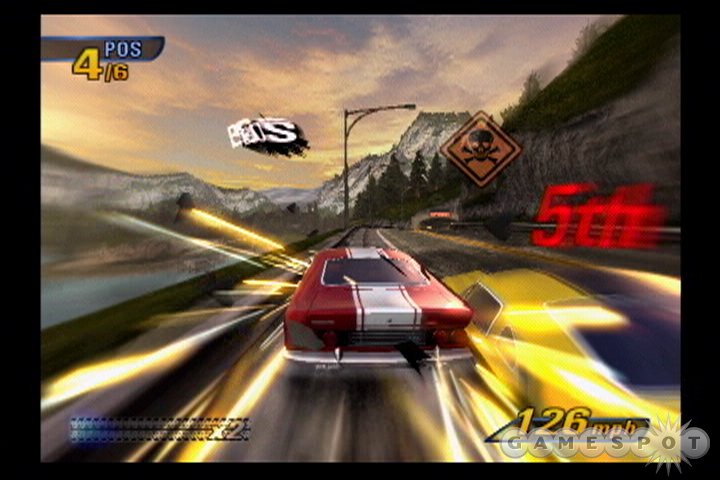
The original Burnout, released back in 2001, was a great arcade-style racing game. It delivered a sense of speed that most games lacked, and it also showcased some pretty spectacular crashes. In fact, the crashes were so cool that they were spun off into their own mode of play in Burnout 2. The crash mode in Burnout 2 was totally separate from the main racing game, but the puzzle-like challenge of wrecking your car in the right spot and at the right time caused the most spectacular, most damaging multicar pileups, which represented an amazing addition to the game. Burnout 3 expertly combines the two main elements of the series while also adding some great, new gameplay modes, a career mode that ties all of these different modes together, good split-screen support, and online play that supports up to six players on the same racetrack. These changes and added features drastically improve a series that was already very impressive.
Burnout 3, like the previous games in the series, is mainly a racing game that rewards you for living dangerously. The game features simple, extremely responsive controls, so you can accelerate, steer, brake (around corners), and boost for a burst of speed. The courses in the game are open-road tracks on winding freeways and city streets, and, naturally, the streets are populated with a good amount of traffic. Driving dangerously comes in the form of driving in the wrong lane, getting close to (but not hitting) other cars, catching air, drifting around turns, and so on. When you pull such risky maneuvers, you're rewarded with boost. But the quickest way to fill your boost meter in a regular race is to make your opponents crash. Takedowns, as you might imagine from the game's subtitle, are a major part of Burnout 3. When you knock another car out, not only is your boost meter filled, but also it's extended up to a maximum of four times its original size. The downside is that you'll expose yourself to some pretty dangerous situations to earn all this boost, and crashing will eliminate much of your boost, chop off one of your bonus meter segments if you have any, and, more than likely, cause you to fall back one or two spots in a race. For an easy-to-play racing game, Burnout 3 actually gives you a lot to consider.
The other big gameplay mechanic in Burnout 3 makes the crashes much more exciting and interactive. When you crash, you can drop the game into a slow-motion mode called impact time, which makes for a very interesting and even innovative dynamic where the pacing of the game can drastically shift for a few moments if you crash. While this slow-motion look at cars getting mangled is beautiful in and of itself, you can actually make light adjustments to your car's trajectory using the left analog stick or d-pad, which is something the game calls "aftertouch." By applying aftertouch when you crash, not only can you stack your car into trucks, tankers, and other cars--just for the heck of it--but also you can attempt to knock into your opponents during a race. If you're successful, you'll earn an aftertouch takedown, which refills your boost meter and prevents you from losing any bonus meter segments. Basically, it functions as a recovery move. The fact that Burnout 3 makes crashing--which is usually the most undesirable part of competition in a racing game--a completely enjoyable part of the game is remarkable. Burnout 3's crash mode has also been completely redesigned to take advantage of aftertouch, so you'll have to do more than just wreck into the right spot this time around. Instead you'll need to maneuver your vehicle's carcass around for best results. It's a strange and surprisingly well-thought-out addition to the game.
There are several different types of events in Burnout 3 that build on the basic concepts of driving dangerously and making the most of your wrecks. Many of them can be played on their own or in an offline or online multiplayer setting, but a few of them only really come up during the game's world tour mode. The most standard mode of them all is the single race. A single race puts you and five opponents on the track, and, as the name suggests, you race. Some tracks feature multiple laps, while others are long enough to be one-lap affairs. The game has a good variety of environments, and multiple tracks are set up in each one by using the old Ridge Racer-style system of opening up certain paths while closing others to make the most of each section of road. The career mode occasionally strings three races together into a grand prix event, where you'll earn points at the end of each race based on your finishing position. There's definitely a good amount of variety here.
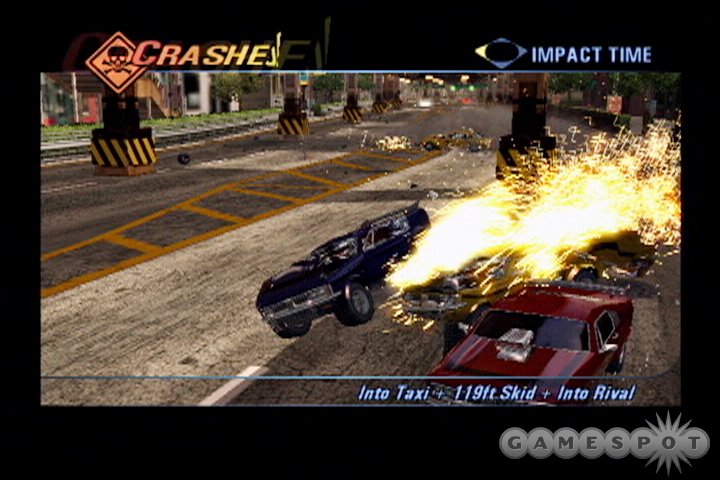
Crash mode returns to Burnout 3 with the same goal as in Burnout 2--to create the largest, most expensive pileup possible. The crash junctions still have a puzzle-like quality to them in that you'll have to figure out the most efficient crash spot in each level. However, with the addition of aftertouch and a series of on-track power-ups, the mode feels totally different from how it did in Burnout 2. Controlling your crash brings a lot of depth to the mode. Some power-ups are merely cash bonuses, whereas others are score multipliers, which are very important. Also, you won't have infinite boost right out of the gate here. You'll have to pick up a boost icon, at which point you'll boost whether you like it or not.
Crash mode also benefits from a new function called the "crashbreaker." This basically lets you make your car spectacularly explode on command. However, you can only trigger it after a certain number of cars have become involved in the wreck. There are also instant crashbreaker power-ups on the track that, as you might expect, cause an instant crashbreaker, effectively letting you blow up twice in the same level. This makes the basic progression much deeper than simply wrecking you car and watching the fun unfold. Now, a common crash junction has you getting the boost icon, maneuvering to wreck into something big, then aftertouching over to a score multiplier or other bonus. Once you reach the crashbreaker threshold, pop that sucker, and use your second wind to aftertouch over to both some cars you may have missed and another power-up. And if you're really looking to break stuff, there's an instant crashbreaker power-up. The junctions get pretty elaborate, and you really have to think on your feet to cause the biggest wrecks. The results tend to be immensely satisfying in ways that are unique to Burnout 3 in particular, since its crash mode is so bizarre and yet so good.
There are also a few different multiplayer crash options to choose from. You can play two-player games online or offline, and you can either cooperate to cause an even bigger crash, or you can work against each other to see who can cause the biggest pileup. The party crash mode--which is the game's only online mode that goes all the way up to eight players--is a simple score competition where each player crashes in the same junction, and then scores are compared. At the end of each round, the most damaging crash is replayed for all to see. This is an interesting mode, online, but since you aren't exactly interacting with the other players beyond voice chatting during your wrecks, it's not the most impressive mode the game has to offer.
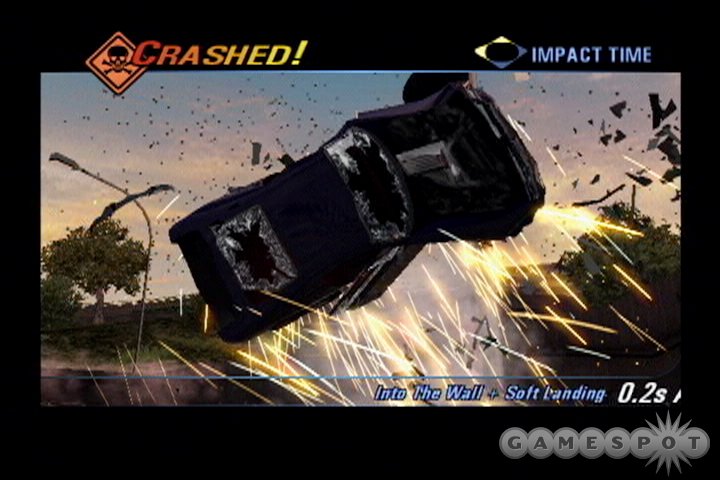
The other modes in the game are standard variants on the basic format. You'll face off against one other car in a race that, if won, unlocks the opposing vehicle for your own use. The burning lap is a solo race against the clock that gives you the maximum boost meter length and essentially challenges you to boost your way around the entire track to meet or beat some pretty challenging lap times. Road rage gives you a time limit and a never-ending stream of opponent cars. The gold medal is won by achieving a specific number of takedowns before time--or before your banged-up car--expires. Online, you can play road rage in teams, where the blue team tries to escape while the red team, often with infinite boost, tries to catch up to take the drivers out before a certain number of miles have been logged. Eliminator races are five lap races that disqualify the last-place car at the end of every lap, making the final lap a one-on-one showdown.
Tying all of the single-player modes together is the world tour mode, which is essentially a large map full of different events. This career-type mode is good at letting you do what you want to do, since you'll usually have a great deal of races available at any given time. Single races eventually lead to grand prix events, burning laps, road rage, crash junctions, eliminator races, face-offs, and so on. The goal in each event is to earn a medal. You can earn bronze medals and still progress through the game, but to unlock the most cars and events, you'll want to take the time to go for the gold. The world tour mode is very good at throwing a lot of unlockable content at you right off the bat, though as you progress, the new cars start to dry up a bit.
The world tour mode is fantastic at ramping up the difficulty at a manageable pace. The first set of cars you get--the compact series--already feels like its cars go incredibly fast. But at this speed, beginners will still feel like they have just enough time to react to little things like, say, an oncoming semi truck. Then you'll move up to the muscle series, which is a little faster and looser but is still manageable--once you get used to the upgrade. These performance boosts keep coming until you hit the super series, which is faster still--and is significantly harder than the early portions of the game. But since you've been working your way up through the ranks little by little, the difficulty never feels too hard.
Your computer-controlled opponents add to the mayhem quite well. Usually, at the start of a race, they'll drive in a fairly passive manner. But they don't take kindly to aggressive drivers such as you. If you knock one of them around, the icon above his or her car will change color, eventually becoming a deep red, at which point the driver will be out for blood--yours. Angered artificial intelligence will knock you around, attempt to force you into walls or oncoming traffic, and generally make your life more difficult (just as a human player would). But it's also to your advantage to fight with your foes, because the boost bonuses are significant. Additionally, the races are kept challenging by AI that is designed to keep races close. While most games use this "rubber band" effect in a noticeably negative way, here it works very well. In fact, Burnout 3 wouldn't be as intense if you could sustain a comfortable lead. You'll occasionally pull ahead of the pack and get into a situation where you can crash once or twice without losing the lead, but for the most part, you need to stay on your toes and race well to win. This works in reverse too, so it's possible for you to come back from worst to first, provided you're driving in a risky enough fashion to earn sufficient boost to catch up to the pack.
While the crashes are flashy and spectacular, the most impressive part of Burnout 3 is its pure sense of speed. This is something that most other racing games simply can't seem to get right--at least not compared with this one. In Burnout 3, racing at 150mph feels about as dangerous as it should. Boosting in a super series car will get you up around the 200mph mark, which feels ridiculously fast, especially when you factor in the relative speeds of oncoming drivers. The sense of speed combines with things like oncoming traffic to make Burnout 3 a truly white-knuckle experience. If all games could maintain this level of intensity from start to finish, avid game players would be going gray well before their times.
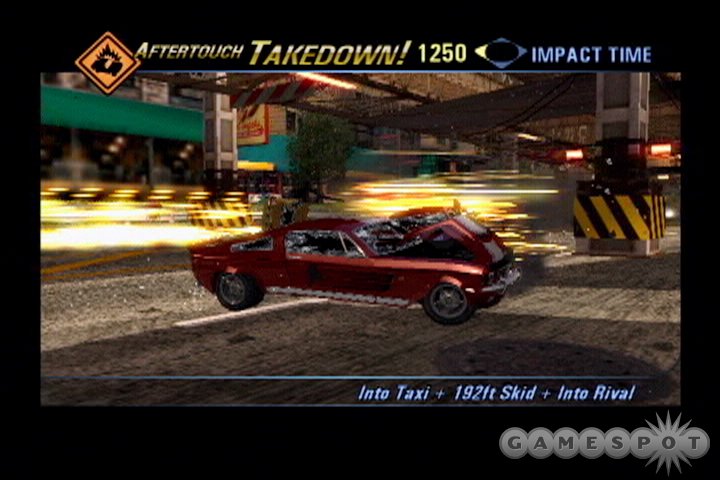
Burnout 3 has online support for up to eight players on both the PlayStation 2 and the Xbox, though when it comes to actually putting all the players into one race, your maximum limit is six contestants. Most of the game's modes--from single race, to a variety of crash modes, to team road rage--are available for play online. The game has an extensive set of leaderboards that will rank you in a variety of categories, and you're able to restrict races to specific ranks or series of cars when creating a game just to keep things fair. The best thing that can be said about the online support in Burnout 3 is that it works very, very well. If one player has a particularly laggy connection, you might see that car skip around the course a bit, but for the most part, the game handles all six drivers--as well as a full complement of traffic to dodge--amazingly. Notably, the slow-motion portion of crash aftertouch is removed when you're playing online, which gives online play a slightly different feel.
Both the PS2 and Xbox versions of the game support voice chat and have "quickmatch" options to get you into a race quickly. Xbox Live owners might be puzzled by some of the EA-specific modifications that the publisher has made to the standard Xbox Live feature set, but what really matters is that you can find a game and get into a game with very little trouble. The game is playable with players from around the world, though those with NTSC copies of the game won't be able to play against PAL users due to the speed and timing changes inherent in making a game for both standards. Just like in the world tour mode, you'll earn points for your online performance, and these go toward unlockable cars.
You'll earn cars in different ways throughout Burnout 3, but perhaps the most satisfying way to earn them is by reaching specific score plateaus. The game keeps track of how many takedowns you've pulled against your opponents and how much monetary damage you've caused in crash mode--and it also tracks a global Burnout score that you get for driving skillfully, crashing stylishly, and so on. Each of these different counters will get you a car from time to time, and the points can come in whether you're online or off. Some of the higher-ticket crash vehicles--like the fire truck--cost a lot of money, so you won't see these during your first weekend of play. These unlockables, combined with the lengthy world tour mode, give Burnout 3 a fantastic amount of replay value. When you add in the online support and how well it's all tied together, you have a driving game that you won't be putting down anytime soon--and not just because of its outstanding gameplay.
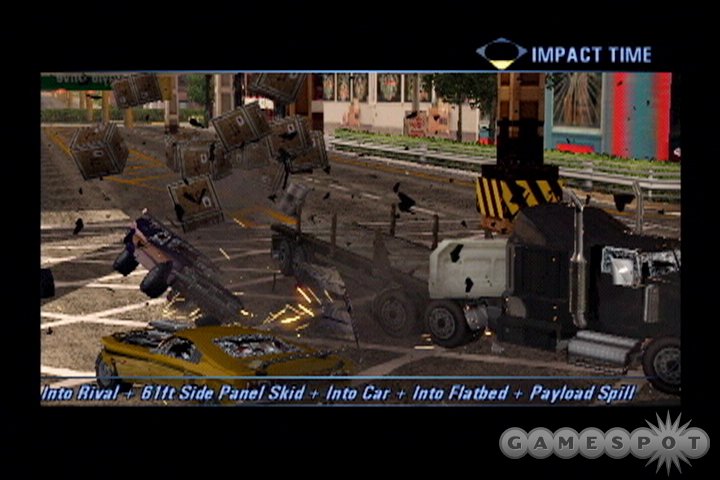
When it comes to graphics, Burnout 3's main focus is on its sense of speed, which is achieved by an extremely fast frame rate and some impressive special effects, such as those for motion blur. But the game also has an astonishing particle-effects system that makes the crashes look better than ever. You'll see sparks flying off of your car when you grind it against something, large chunks of metal fly off of the car when you crash, and the game really looks superb from top to bottom. The car models look really great. Even though they aren't the most detailed car models in the business and they aren't real cars, considering how fast most of them fly by, you'll hardly notice. The game's frame rate stays surprisingly solid in both versions of the game, which really helps sell the sense of speed. Burnout 3 has a pretty incredible physics model working behind the scenes that makes the darkly humorous crashes worth watching every single time. Both games have support for progressive scan and 16:9 displays. Both versions look awesome on their respective platforms, but when you compare the two, the Xbox version wins the fight easily.
It's worth noting that with the Burnout series moving from the now-defunct Acclaim over to Electronic Arts, some of EA's standard touches have made it into the game in the form of product placement. You'll definitely notice ads for EA's upcoming games on the sides of almost every course, along with an occasional cologne ad. The ads stick out a bit too much and become annoying almost immediately. Considering how great the backdrops in each track look, it's a bit disappointing to see them marred by advertising. You might also be frustrated that when you play the game's main modes for the first time, you'll have to sit through a few minutes of unskippable training video. It's nicely produced, but the game itself is easy to get into, so the tutorial should have been skippable. The audio has a few similar touches to it that aren't entirely welcomed.
Make no mistake. Burnout 3's audio is great. Actually, the sounds of driving, from the roar of your engine, to the rush of wind as you pass oncoming traffic, to the loud thunks of your car shifting gears, to the bass-heavy whoosh that kicks in when you hit your boost, are incredible. However, these sounds are counterbalanced by a few negatives. The game is missing a few key noises that would have added to the sense of realism. For instance, you really don't hear much when you scrape your car against a guard rail. It would seem that the obvious shower of sparks would be accompanied by some sort of grinding noise. But the real culprits are the game's announcer and soundtrack. Burnout 3's soundtrack is treated like a radio station called Crash FM. The DJ, a knucklehead alt-rock jock called Striker, is merely annoying to begin with, but when you hear him repeat the same handful of phrases time and time again, you'll do the right thing and turn him off in the game's options menu.
The soundtrack is full of a bunch of populist indie rock and pop-punk that might be doing well on the radio these days, but the tempo and style of the music doesn't necessarily mesh with very-high-speed driving. On the Xbox, you'll fortunately be able to use the custom soundtrack feature to fix this to your liking. On the PS2, you're out of luck unless you want to just turn the music down entirely. Considering how awesome the sounds of driving are in the game, this actually isn't a bad choice. Finally, the Xbox version supports Dolby Digital 5.1, while the PlayStation 2 only supports Pro Logic II. The end result is that bass effects--such as the sound of boosting--are much clearer and deeper on the Xbox.
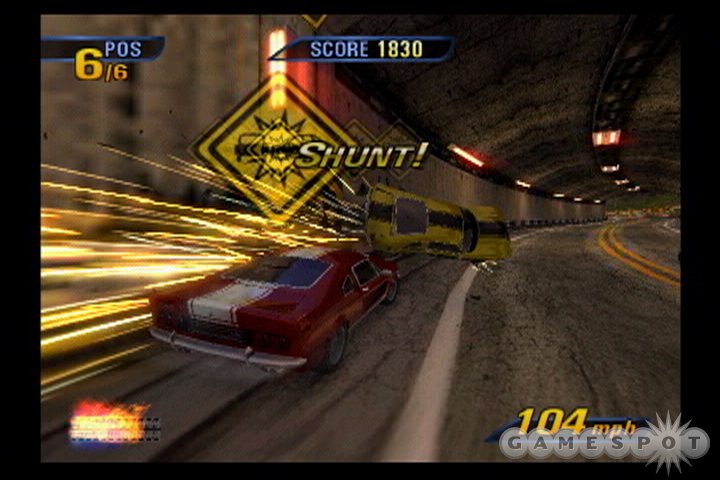
It's also worth mentioning that the loading times in Burnout 3 are a little longer than you'd probably like them to be. The Xbox is much faster than the noticeably poky PlayStation 2 version, but you'll still be waiting a bit longer than you'd like, regardless of which version you're playing. That's mostly because you won't want to be waiting at all before your next race or crash.
Unless your only idea of driving-game enjoyment involves playing the strictest of simulations, Burnout 3: Takedown is the driving game for you. It's instantly accessible, yet it has more than enough challenge to it to keep you busy for a very long time, even if you don't intend to play the game online. Furthermore, it's simply one of the most exciting, action-packed games to come along in a long time, regardless of genre. So even if driving games aren't normally your thing, if you're a thrill-seeker (at least in game terms), this offering has them in spades. Burnout 3: Takedown is an amazing achievement that anyone with a pulse will probably love.
Editor's note 09/09/04: The review originally stated that the PlayStation 2 version of Burnout 3 did not support progressive scan displays, which is incorrect. GameSpot regrets the error.